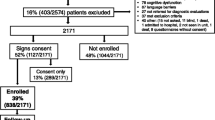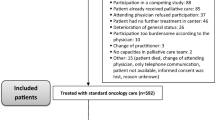Abstract
Introduction
Data on the impact of desmoid type fibromatosis (DTF) on emotional distress and health-related quality of life (HRQoL) is sparse.
Methodology
In this prospective cross-sectional study, patients with DTF and healthy controls were asked to fill the EORTC QLQ-C30, GAD-7, and PHQ-9 questionnaires. The objectives were to determine HRQoL, anxiety, and depression in patients with DTF.
Results
Two hundred four subjects (102 DTF patients and 102 healthy controls) were recruited. The median age of DTF patients at recruitment into the study was 31 years (IQR, 25–37 years). There was a female preponderance with a male:female ratio of 1:1.83. Appendicular skeleton and abdomen sites were most commonly involved in 59% and 22.5% respectively. About half (54%) of patients were currently on sorafenib and 41% were under active surveillance. The mean global health status in DTF patients was 65.58 ± 22.64, significantly lower than healthy controls. Similarly, DTF patients scored low on all functional scales except cognitive functioning. The symptom scale showed a significantly higher symptom burden of fatigue, pain, insomnia, and financial difficulties. Anxiety and depression was observed in 39.22% and 50% of DTF patients respectively. DTF patients had higher rates of mild, moderate, and severe anxiety and depression compared to healthy controls.
Conclusion
DTF patients have significant symptom burden, poor functioning, and heightened anxiety and depression as compared to healthy controls. HRQoL, anxiety, and depression should be routinely used to assess symptom burden and treatment efficacy in DTF patients.

Similar content being viewed by others
Data availability
The datasets used and/or analysed during the current study are available from the corresponding author on reasonable request.
References
Devata S, Chugh R (2013) Desmoid tumors: a comprehensive review of the evolving biology, unpredictable behavior, and myriad of management options. Hematol Oncol Clin North Am 27(5):989–1005
Chew C, Reid R, O’Dwyer PJ (2004) Evaluation of the long term outcome of patients with extremity desmoids. Eur J Surg Oncol J Eur Soc Surg Oncol Br Assoc Surg Oncol 30(4):428–432
Penel N, Coindre J-M, Bonvalot S, Italiano A, Neuville A, Le Cesne A et al (2016) Management of desmoid tumours: a nationwide survey of labelled reference centre networks in France. Eur J Cancer 1(58):90–96
Fiore M, Rimareix F, Mariani L, Domont J, Collini P, Le Péchoux C et al (2009) Desmoid-type fibromatosis: a front-line conservative approach to select patients for surgical treatment. Ann Surg Oncol 16(9):2587–2593
Gounder MM, Maddux L, Paty J, Atkinson TM (2020) Prospective development of a patient-reported outcomes instrument for desmoid tumors or aggressive fibromatosis. Cancer 126(3):531–539
Desmoid Tumor Working Group (2020) The management of desmoid tumours: a joint global consensus-based guideline approach for adult and paediatric patients. Eur J Cancer Oxf Engl 1990 127:96–107
Improta L, Tzanis D, Bouhadiba T, Abdelhafidh K, Bonvalot S (2020) Desmoid tumours in the surveillance era: what are the remaining indications for surgery? Eur J Surg Oncol J Eur Soc Surg Oncol Br Assoc Surg Oncol 46(7):1310–1314
van Houdt WJ, Husson O, Patel A, Jones RL, Smith MJF, Miah AB et al (2019) Outcome of primary desmoid tumors at all anatomic locations initially managed with active surveillance. Ann Surg Oncol 26(13):4699–4706
Kasper B, Baumgarten C, Garcia J, Bonvalot S, Haas R, Haller F et al (2017) An update on the management of sporadic desmoid-type fibromatosis: a European Consensus Initiative between Sarcoma PAtients EuroNet (SPAEN) and European Organization for Research and Treatment of Cancer (EORTC)/Soft Tissue and Bone Sarcoma Group (STBSG). Ann Oncol Off J Eur Soc Med Oncol 28(10):2399–2408
U.S. Department of Health and Human Services FDA Center for Drug Evaluation and Research, U.S. Department of Health and Human Services FDA Center for Biologics Evaluation and Research, U.S. Department of Health and Human Services FDA Center for Devices and Radiological Health (2006) Guidance for industry: patient-reported outcome measures: use in medical product development to support labeling claims: draft guidance. Health Qual Life Outcomes 11(4):79
Schut A-RW, Timbergen MJM, Lidington E, Grünhagen DJ, van der Graaf WTA, Sleijfer S et al (2021) The evaluation of health-related quality of life issues experienced by patients with desmoid-type fibromatosis (The QUALIFIED Study)—a protocol for an international cohort study. Cancers 13(13):3068
Aaronson NK, Ahmedzai S, Bergman B, Bullinger M, Cull A, Duez NJ et al (1993) The European Organization for Research and Treatment of Cancer QLQ-C30: a quality-of-life instrument for use in international clinical trials in oncology. JNCI J Natl Cancer Inst 85(5):365–376
Timbergen MJM, van de Poll-Franse LV, Grünhagen DJ, van der Graaf WT, Sleijfer S, Verhoef C et al (2018) Identification and assessment of health-related quality of life issues in patients with sporadic desmoid-type fibromatosis: a literature review and focus group study. Qual Life Res 27(12):3097–3111
Husson O, Younger E, Dunlop A, Dean L, Strauss DC, Benson C et al (2019) Desmoid fibromatosis through the patients’ eyes: time to change the focus and organisation of care? Support Care Cancer 27(3):965–980
Spitzer RL, Kroenke K, Williams JB (1999) Validation and utility of a self-report version of PRIME-MD: the PHQ primary care study. Primary Care Evaluation of Mental Disorders. Patient Health Questionnaire. JAMA 282(18):1737–44
Spitzer RL, Williams JB, Kroenke K, Hornyak R, McMurray J (2000) Validity and utility of the PRIME-MD patient health questionnaire in assessment of 3000 obstetric-gynecologic patients: the PRIME-MD Patient Health Questionnaire Obstetrics-Gynecology Study. Am J Obstet Gynecol 183(3):759–769
Swinson RP (2006) The GAD-7 scale was accurate for diagnosing generalised anxiety disorder. Evid Based Med 11(6):184
Spitzer RL, Kroenke K, Williams JBW, Löwe B (2006) A brief measure for assessing generalized anxiety disorder: the GAD-7. Arch Intern Med 166(10):1092–1097
Bruera E, Kuehn N, Miller MJ, Selmser P, Macmillan K (1991) The Edmonton Symptom Assessment System (ESAS): a simple method for the assessment of palliative care patients. J Palliat Care 7(2):6–9
Giesinger JM, Loth FLC, Aaronson NK, Arraras JI, Caocci G, Efficace F, Groenvold M, van Leeuwen M, Petersen MA, Ramage J, Tomaszewski KA, Young T, Holzner B, EORTC Quality of Life Group (2020) Thresholds for clinical importance were established to improve interpretation of the EORTC QLQ-C30 in clinical practice and research. J Clin Epidemiol 118:1–8
Stata 14 StataCorp (2015) Stata statistical software: release 14. StataCorp LP, College Station. Available from: https://www.stata.com/stata14/. Accessed 14 Jan 2021
Gounder MM, Lefkowitz RA, Keohan ML, D’Adamo DR, Hameed M, Antonescu CR et al (2011) Activity of Sorafenib against desmoid tumor/deep fibromatosis. Clin Cancer Res Off J Am Assoc Cancer Res 17(12):4082–4090
Gounder MM, Mahoney MR, Van Tine BA, Ravi V, Attia S, Deshpande HA et al (2018) Sorafenib for advanced and refractory desmoid tumors. N Engl J Med 379(25):2417–2428
Toulmonde M, Pulido M, Ray-Coquard I, Andre T, Isambert N, Chevreau C et al (2019) Pazopanib or methotrexate–vinblastine combination chemotherapy in adult patients with progressive desmoid tumours (DESMOPAZ): a non-comparative, randomised, open-label, multicentre, phase 2 study. Lancet Oncol 20(9):1263–1272
Timbergen MJM, van der Graaf WTA, Grünhagen DJ, Younger E, Sleijfer S, Dunlop A, Dean L, Verhoef C, van de Poll-Franse LV, Husson O (2020) Assessing the desmoid-type fibromatosis patients' voice: comparison of health-related quality of life experiences from patients of two countries. Sarcoma 2020:2141939. https://doi.org/10.1155/2020/2141939, https://www.hindawi.com/journals/sarcoma/2020/2141939/. Accessed 14 Jan 2021
Martínez Trufero J, Pajares Bernad I, Torres Ramón I, Hernando Cubero J, Pazo CR (2017) Desmoid-type fibromatosis: who, when, and how to treat. Curr Treat Options Oncol 18(5):29
Ingley KM, Klein R, Theobalds N, Burtenshaw S, Abdul Razak AR, Chen B et al (2020) High prevalence of persistent emotional distress in desmoid tumor. Psychooncology 29(2):311–320
Alman B, Attia S, Baumgarten C, Benson C, Blay J-Y, Bonvalot S et al (2020) The management of desmoid tumours: a joint global consensus-based guideline approach for adult and paediatric patients. Eur J Cancer 1(127):96–107
Acknowledgements
The authors thank the Sachin Sarcoma Society, New Delhi, India.
Author information
Authors and Affiliations
Contributions
Conception and design: all authors; collection and assembly of data: Vikas Garg, Sameer Rastogi; data analysis and interpretation: Vikas Garg, Sameer Rastogi, Ashish Upadhyay; manuscript writing: all authors; final approval of manuscript: all authors; accountable for all aspects of the work: all authors; authors’ disclosures of potential conflicts of interest: none.
Corresponding author
Ethics declarations
Ethics approval and consent to participate
Prior approval was taken from the Institute’s Ethics Committee For Post Graduate Research, All India Institute of Medical Science (AIIMS), New Delhi (Ref No: IECPG-453/26.08.2020). All methods were carried out in accordance with relevant guidelines and regulations.
Consent for publication
All participants provided their written informed consent.
Competing interests
The authors declare no competing interests.
Additional information
Publisher's note
Springer Nature remains neutral with regard to jurisdictional claims in published maps and institutional affiliations.
Prior presentation: ASCO Virtual Meeting 2021.
Supplementary Information
Below is the link to the electronic supplementary material.
Rights and permissions
Springer Nature or its licensor (e.g. a society or other partner) holds exclusive rights to this article under a publishing agreement with the author(s) or other rightsholder(s); author self-archiving of the accepted manuscript version of this article is solely governed by the terms of such publishing agreement and applicable law.
About this article
Cite this article
Garg, V., Rastogi, S., Kalra, K. et al. Health-related quality of life (HRQoL), anxiety, and depression in patients with desmoid type fibromatosis. Support Care Cancer 30, 10089–10098 (2022). https://doi.org/10.1007/s00520-022-07445-0
Received:
Accepted:
Published:
Issue Date:
DOI: https://doi.org/10.1007/s00520-022-07445-0




